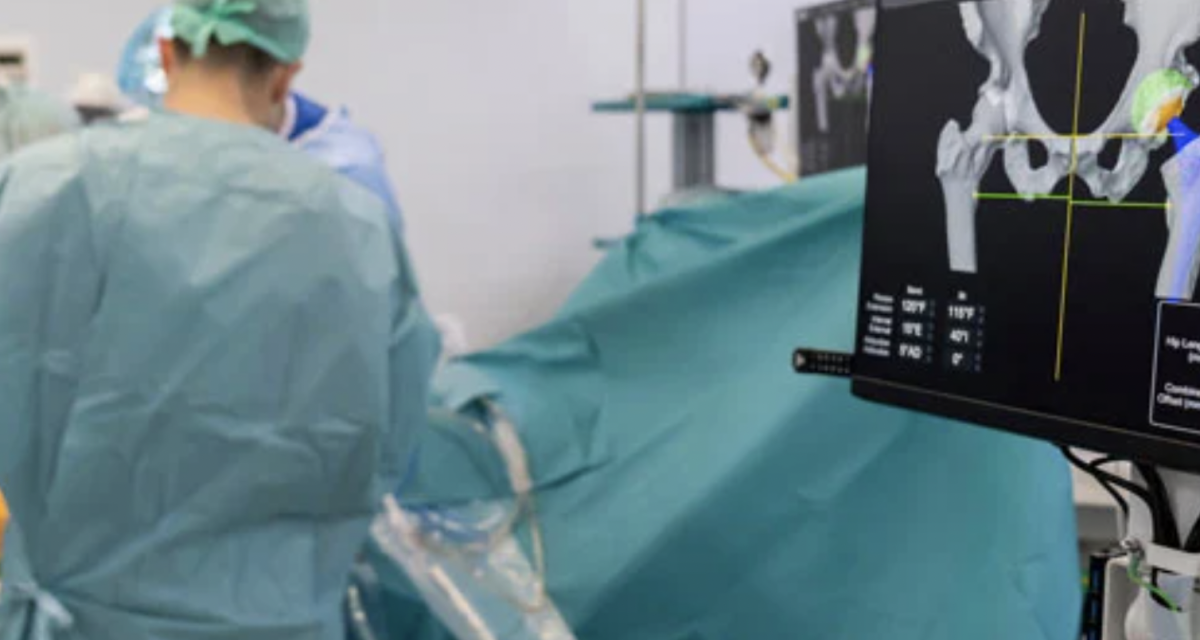10 inspiring companies developing tech for orthopaedic robotic surgery

SOURCE: ESCATEC Blog
Surgical robots are here to stay. They help doctors plan surgeries, improve precision during procedures, and transform traditional techniques into digital procedures. Arguably, of all the medical areas, the uptake of robotics has been the most seamless in orthopaedics. And the demand for orthopaedic products is rapidly increasing.
Orthopaedic robots are perfect assistants during hip and knee joint replacements, as the bone is treated as a fixed object. But orthopaedic device developers are developing products for surgeons working on different areas, including the shoulder and spine. Their tech is providing surgeons with a previously unknown way to standardise procedures and carry out minimally invasive surgeries—likely to lead to a sharp growth in the area.
Key stats in orthopaedic tech development
- According to Strategic Market Research, the global orthopaedic surgical robots market size was $1200.62 million in 2021. It is predicted to reach $6552.29 million by 2030, representing a CAGR of 20.75% between 2021–2030.
- Robotic-assisted surgery is predicted to be the most trending technology in the future.
- According to GlobalData analysis, Robotic-assisted knee reconstruction surgeries, one of the fastest-growing procedures, will likely reach approximately 700,000 globally by 2030, with a CAGR of 8% between 2021–2030.
- There was an exponential increase in patient interest in robotic knee and hip arthroplasty between 2011–2021.
- There is a shifting pattern towards implementing surgical robots to perform orthopedical treatments, which is immensely boosting the market’s growth rate.
Who are the big players in orthopaedic surgery?
In terms of revenue and growth, four global medical device developers of orthopaedic surgical robots stand out above the rest, owning roughly an 80% market share.
1. Medtronic
Medtronic produces various spinal and orthopaedic products, including the Mazor X Stealth Edition, a robotic guidance platform that combines advanced surgical planning software with robotic guidance and Stealth™ Navigation.
The Mazor X Stealth™ Edition robotic guidance system allows for pre-operative or intra-operative planning. Its features include a customisable implant selection, optimal implant trajectories, and 3D analytics. Planning allows the surgeon to achieve construct optimisation and makes the procedure predictable.
The Mazor X robot is table mounted, and the platform secures a connection between the bed-mounted robotic arm, the patient secured on the bed, and a rigid fixation between the robot and the patient’s skeletal anatomy.
2. Stryker
Stryker designs products for robotic-arm assisted surgery: the Mako range. These robots give doctors a more predictable surgical experience when performing knee and hip surgery.
Mako SmartRobotics combines three key components into one platform: 3D CT-based planning, AccuStop haptic technology, and data analytics.
A CT scan creates a 3D image of the patient’s anatomy, allowing doctors to create a patient plan and assess and balance the joint. The Mako AccuStop haptic technology will then enable surgeons to carry out what they previously planned for each patient, for example, preserving soft tissue or saving healthy bone.
3. Zimmer Biomet
Zimmer Biomet develops ROSA Robotic Technology, used in knee replacement surgeries. ROSA Robotics uses data collected before and during surgery to inform the surgeon of essential details about the specific patient’s anatomy. With this data, the surgeon can perform a procedure considering the patient’s unique needs.
There are three unique benefits of using the technology: First, the implant can be better positioned, resulting in a more natural-feeling knee after surgery. Second, there is less patient exposure to radiation. And third, surgeons enjoy increased accuracy compared to traditional knee replacements.
4. Johnson & Johnson
Johnson & Johnson’s work includes the VELYS™ robotic-assisted solution that helps simplify surgeons’ existing workflow. It is designed around how they plan, execute, and perform surgery for total knee replacement. The technology is a table-mounted robot that helps accurately resect bones and aligns and positions the implant relative to the soft tissue without needing pre-operative imaging.
Who are the mid-sized players?
5. Smith and Nephew
Smith and Nephew develop the CORI and NAVIO surgical systems.
The CORI is an intelligent platform that supports robotics, software, smart tools and data. It is a surgeon-controlled, handheld intelligence for a modern robotic approach that provides image-free, smart mapping; real-time planning and gap assessment; and optimised alignment and balance.
The NAVIO surgical system is designed to help surgeons improve outcomes and patient satisfaction. It claims to currently be the only handheld robotics system for knee surgery and features the most extensive portfolio of compatible implants for total and partial knee arthroplasty.
6. Globus Medical
Globus Medical designed ExcelsiusGPS, a multifunctional robotic navigation platform that provides unique real-time information throughout spine surgery. It combines a rigid robotic arm and full navigation capabilities into one adaptable platform. The technology was created to provide accurate trajectory alignment in spine surgery and was designed to enhance safety and improve efficiency for patients, staff, and surgeons in the operating room.
7. NuVasive
NuVasive works in spine technology innovation and is focused on transforming spine surgery with minimally disruptive, procedurally integrated solutions. The company developed the Pulse™ Surgical Robotics System, an integrated technology platform, including multiple technologies designed to help surgeons adopt more efficient, less disruptive surgical approaches in all spine procedures. It is engineered to improve workflow, reduce variability and increase surgical reproducibility.
Having been awarded the CE mark in 2021, clinical trials are now underway in Europe.
And who are the up-and-coming players?
8. Galen Robotics
Galen Robotics is attempting to make surgeons’ lives easier through assistive technology in the operating room. The company has developed a surgical robotic platform for many types of surgery, including spine surgery. The Galen platform is designed to work with standard surgical instruments, improving stability and ergonomics in a variety of narrow corridor and minimally invasive procedures. Galen Robotics recently filed for clearance with the FDA. Upon clearance, the company expects to be the first to launch a surgical robotic platform “as a service.”
9. HOLO Surgical
HOLO Surgical developed the HOLO Portal surgical guidance system to enhance intraoperative image-guided navigation with AI-driven insights. Although it is not a robot, it was developed to address visualisation limitations and the lack of intelligent guidance offered by current robotic systems.
The system allows the surgeon to see the patient’s entire internal anatomy without soft tissue exposure, gives automatic anatomy identification and provides autonomous surgical planning and computer guidance throughout the surgery. Additionally, AI algorithms allow the technology to adapt to surgeons using big data-based guidance.
10. OrthAlign
OrthAlign develops handheld disposable navigation devices for knee and hip replacement surgeries. They work together with surgical robots to provide real-time data for the precise positioning of implant components.
What are the benefits of using robots in orthopaedic surgery
The main benefit of robot-assisted orthopaedic surgery is the increased level of precision they offer.
- In spine surgery, robotic guidance system aids surgeons in making a minimally invasive incision and inserting the orthopaedic implants more precisely.
- In orthopaedic trauma, robots improve closed fracture reduction and reconstruction.
- Other benefits for fracture surgery include being able to precisely guide the implant as well as inserting and manipulating screws and bolts.
- Robots allow minimally-invasive surgery, meaning smaller incisions resulting in less scarring and reduced risk of infection.
- This also helps to reduce blood loss, pain, and discomfort post-surgery.
- Recovery time after robotic surgery is generally faster.
Conclusion
The many proven benefits and success of orthopaedic robots have led to high demand for the products—from patients and doctors. This is likely to increase exponentially. Robots are digitalising traditional medicine and revolutionising surgical procedures; the companies developing these products are improving healthcare for everyone.













